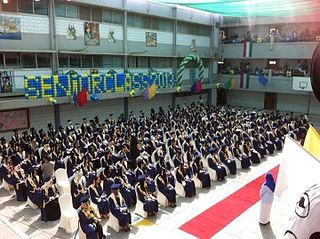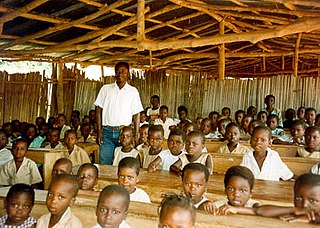
Cameroon is a Central African nation on the Gulf of Guinea. Bantu speakers were among the first groups to settle Cameroon, followed by the Muslim Fulani until German domination in 1884. After World War I, the French took over 80% of the area, and the British 20%. After World War II, self-government was granted, and in 1972, a unitary republic was formed out of East and West Cameroon. Until 1976 there were two separate education systems, French and English, which did not merge seamlessly. French is now considered the primary language of instruction. Local languages are generally not taught as there are too many, and choosing between them would raise further issues.

Education in North Korea is universal and state-funded schooling by the government. As of 2021, UNESCO Institute for Statistics does not report any data for North Korea's literacy rates. Some children go through one year of kindergarten, four years of primary education, six years of secondary education, and then on to university. The North Korean state claims its national literacy rate for citizens aged 15 and older is 100 percent.

The education system in Switzerland is very diverse, because the constitution of Switzerland delegates the authority for the school system mainly to the cantons. The Swiss constitution sets the foundations, namely that primary school is obligatory for every child and is free in state schools and that the confederation can run or support universities.

The system of education in Uganda has a structure of 7 years of primary education, 6 years of secondary education, and 3 to 5 years of post-secondary education. Education in Uganda is administered in English. All throughout the levels in the education structure, modules are taught and assessed in English. The government of Uganda recognizes education as a basic human right and continues to strive to provide free primary education to all children in the country. However, issues with funding, teacher training, rural populations, and inadequate facilities continue to hinder the progress of educational development in Uganda. Girls in Uganda are disproportionately discriminated against in terms of education; they face harsher barriers when trying to gain an education and it has left the female population disenfranchised, despite government efforts to close the gap.

Education in Rwanda has undergone considerable changes throughout Rwanda's recent history, and has faced major disruptions due to periods of conflict. Education was divided by gender whereby women and men had a different education relevant to their responsibilities in day-to-day life. Women were mostly taught housekeeping while men were mainly taught how to hunt, raise animals, and fish. This is because Rwanda was a community-based society where every member had a specific contribution to the overall development of the community. Older family members like grandparents usually took on the role of educators.

Education in the Syrian Arab Republic is given the necessary attention and care by the Syrian state, as the Syrian Constitution guarantees the right to education to every citizen, which is compulsory and free at primary level. It is free but not compulsory at the secondary level and higher education is available for a symbolic fee. the primary level includes 2 stages, 1 & 2 which include grades 1 to 6 while the secondary school includes grades 7 to 10
Education in Algeria is free and compulsory for Algerians from the ages of 6 to 15. However, only half of Algerian students are enrolled in secondary schools. As of 2015, Algeria has 92 post-secondary institutions, which includes 48 universities.

Before the arrival of European settlers, who introduced a formal education system addressed to the elites, education in Ghana was mainly informal and based on apprenticeship. Economic activities in pre-colonial Ghana were based on farm produce shared within households and members of each household specialized in providing necessities such as cooking utilities, shelter, clothing, and furniture, and trade with other households was therefore practiced on a very small scale. As such there was no need for employment outside the household that would have otherwise called for disciplines, values, and skills through a formal education system. After colonization, Ghana's economy became a hybrid of subsistence and formal economy.

Education in Cambodia is controlled by the state through the Ministry of Education in a national level and by the Department of Education at the provincial level. The Cambodian education system includes pre-school, primary, secondary education, higher education and non-formal education. The education system includes the development of sport, information technology education, research development and technical education. School enrollment has increased during the 2000s in Cambodia. USAID data shows that in 2011 primary enrollment reached 96% of the child population, lower secondary school 34% and upper secondary 21%.

The Constitution mandates free and compulsory primary education in the Gambia, but a lack of resources and education infrastructure has made implementation difficult. In 1995, the gross primary enrollment rate was 77.1 percent and the net primary enrollment rate was 64.7 percent. School fees long prevented many children from attending school, but in February 1998 the president of the Gambia ordered the termination of fees for the first six years of schooling. Girls make up about 40 percent of primary school students, though the figure is much lower in rural areas where cultural factors and poverty prevent parents from sending girls to school. Approximately 20 percent of school-age children attend Koranic schools, which usually have a restricted curriculum.

Education in Mali is considered a fundamental right of Malians. For most of Mali's history, the government split primary education into two cycles which allowed Malian students to take examinations to gain admission to secondary, tertiary, or higher education. Mali has recently seen large increases in school enrollment due to educational reforms.
Education in Kyrgyzstan is compulsory for nine years, between ages seven and 15. Following four years of primary and five years of lower secondary school, the system offers two years of upper secondary school, specialized secondary school, or vocational/technical school.

The State of Kuwait, located at the head of the Persian Gulf, supports an educational policy that seeks to provide an opportunity to all children, irrespective of their social class, including children with special needs. Kuwait was ranked 63rd on the Human Development Index report for 2011 by the United Nations Development Programme, placing Kuwait above the regional average.

In 2005, the literacy rate in Laos was estimated to be 73%.

Education in Angola has six years of compulsory education, under the Angolan Education Law (13/01) of 31 December 2001. Basic adult literacy continues to be low, but there are conflicting figures from government and other sources. It is difficult to assess literacy and education needs. According to 2015 estimates, the literacy rate in Angola is 71.1% . On the other hand, the university system has been developing considerably over the last decade.

Education in Ivory Coast continues to face many challenges. Among sub-Saharan African countries, Ivory Coast has one of the highest literacy rates. According to The World Factbook - Central Intelligence Agency as of facts. The literacy rate for adults remains low: in 2000, it was estimated that only 48.7% of the total population was literate. Many children between 6 and 10 years are not enrolled in school, mainly children of poor families. The majority of students in secondary education are male. At the end of secondary education, students can sit the Baccalauréat examination. The country has universities in Abidjan, Bouaké, and Yamoussoukro.

Education in Uruguay is compulsory for a total of fourteen years, beginning at the preschool level, and is free from the pre-primary through the university level. In 1996, the gross primary enrollment rate was 111.7 percent, and the net primary enrollment rate was 92.9 percent. Primary school attendance rates were unavailable for Uruguay as of 2001.

Benin has abolished school fees and is carrying out the recommendations of its 2007 Educational Forum. In 2018, the net primary enrollment rate was 97 percent. Gross enrollment rate in secondary education has greatly increased in the last two decades, from 21.8 percent in 2000 to 59 percent in 2016, 67.1 percent in the case of males and 50.7 percent for females. Because of a rapid increase in the enrollment rate, the student/teacher ratio rose from 36:1 in 1990 to 53:1 in 1997 but has dropped again in the last years to 39:1 (2018). In 2018, the gross enrollment ratio in tertiary education was 12.5%.

There have been major strides with Education in Equatorial Guinea over the past ten years, although there is still room for improvement. Among sub-Saharan African countries, Equatorial Guinea has one of the highest literacy rates. According to The World Factbook - Central Intelligence Agency as of 2015, 95.3% of the population age 15 and over can read and write in Equatorial Guinea were respectively literate. Education in Equatorial Guinea is overseen by the Ministry of Education and Science (MEC). Split into four levels, preschool, primary, secondary, and higher education, the Equatorial Guinea's educational system only deems preschool and primary school mandatory. Education in Equatorial Guinea is free and compulsory until the age of 14. Although it has a high GNI per capita, which, as of 2018, was 18,170 international dollars, its educational outcomes fall behind those of the rest of West and Central Africa. In 1993, the gross primary enrollment rate was 149.7 percent, and the net primary enrollment rate was 83.4 percent. Late entry into the school system and high dropout rates are common, and girls are more likely than boys to drop out of school. As of 2015, the net enrollment rates for each education level are as follows: 42 percent for preschool, between 60 percent and 86 percent for primary school, and 43.6 percent for secondary school. UNESCO has cited several issues with the current educational system, including poor nutrition, low quality of teachers, and lack of adequate facilities.
Education in Lesotho has undergone reforms in recent years, meaning that primary education is now free, universal, and compulsory.




















